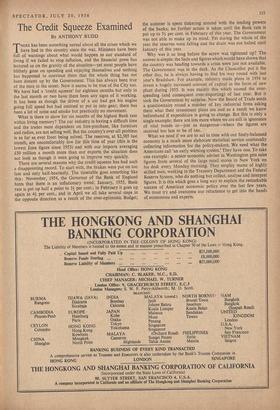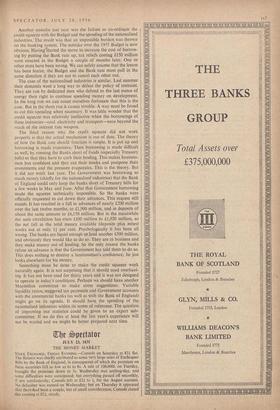The Credit Squeeze Examined
BY ANTHONY RUDD THERE has been something unreal about all the crises which we have had in this country since the war. Ministers have been full of warnings about what would happen to our standard of living if we failed to stop inflation, and the financial press has lectured us on the gravity of the situation—yet most people have blithely gone on spending and enjoying themselves and nothing has happened to convince them that the whole thing has not been dreamt up by the Government. This has always been true of the man in the street. Now it seems to be true of the City too. We have had a 'credit squeeze' for eighteen months but only in the last month or two have there been any signs of it working. It has been as though the driver of a car had got his engine going full speed but had omitted to put in into gear; there has been a lot of noise and smoke but practically no movement.
What is there to show for six months of the highest Bank rate within living memory? The car industry is having a difficult time and the trades most dependent on hire-purchase, like furniture and radios, are not selling well. But the country's over-all problem is as far as ever from being solved. The reserves, at $2,385 last month, are uncomfortably low for this time of year (this is the lowest June figure since 1953) and with our imports averaging £50 million a month more than our exports the situation does not look as though it were going to improve very quickly.
There are several reasons why the credit squeeze has had such a disappointing record. To start with, the brakes were put on too late and only half-heartedly. The timetable goes something like this: November, 1954, the Governor of the Bank of England hints that there is an inflationary trend; January, 1955, Bank rate is put up half a point to 34 per cent.; in February it goes up again to 44 per cent., and in April we all take several steps in the opposite direction as a result of the over-optimistic Budget; the summer is spent tinkering around with the lending powers of the banks; no further action is taken until the Bank rate is put up to 54 per cent. in February of this year. The Government was not able to make up its mind., Yet during the whole of the year the reserves were falling and the drain was not halted until January of this year.
Why was it so long before the screw was tightened up? The answer is simple: the facts and figures which would have shown that the country was heading towards a crisis were just not available. The Government was in the dark. As the Chancellor put it the other day, he is always having to find his way round with last year's Bradshaw. For example, industry made plans in 1954 to invest a hugely increased amount of capital in the form of new plant during 1955. It was mainly this which caused the over- spending (and consequent over-importing) of last year. But it took the Government by surprise. Now the Board of Trade sends a questionnaire round a number of key industrial firms asking them what their investment plans are and as a result we know beforehand if expenditure is going to change. But this is only a single example; there are lots more where we are still in ignorance of vital trends or—just as dangerous—where the figures are received too late to be of use.
What we need if we are to act in time with our finely-balanced economy is a much more elaborate statistical service continually collecting information for the policy-makers. We need what the Americans call 'an early warning system.' They have one. To take one example : a senior economic adviser in Washington gets sales figures from several of the large retail stores in New York on his desk every Monday morning. They employ teams of highly skilled men, working in the Treasury Department and the Federal Reserve System, who do nothing but collect, analyse and interpret figures. It is this which goes a long way to explain the remarkable success of American economic policy over the last few years. We must try and overcome our reluctance to get into the hands of economists and experts. Another mistake last year was the failure to co-ordinate the credit squeeze with the Budget and the spending of the nationalised industries. The result was that an impossible burden., was thrown on the banking vstem. The mistake over the 1955 Budget is now obvious. Having started the move to increase the cost of borrow- ing by putting the Bank rate up, tax reliefs costing £150 million were enacted in the Budget a couple of months later. One or other must have been wrong. We can safely assume that the lesson has been learnt;. the Budget and the Bank rate must pull in the same direction if they are not to cancel each other out.
The case of the nationalised industries is similar. Last summer their demands went a long way to defeat the policy of restraint. They are run by dedicated men who defend to the last ounce of energy their right to continue spending money on development. In the long run we can count ourselves fortunate that this is the case. But in the short run it causes trouble. A way must be found to cut this spending when necessary. It was little wonder that the credit squeeze was relatively ineffective when the borrowings of these industries—coal, electricity and transport—were beyond the reach of the interest rate weapon.
The third reason why the credit squeeze did not work properly is that the actual mechanism is out of date. The theory of how the Bank rate should function is simple. It is put up and borrowing is made expensive. Then borrowing is made difficult as well, by running the Banks short of funds (especially Treasury bills) so that they have to curb their lending. This makes business- men less confident and they cut, their stocks and postpone their investments and the pressure evaporates. This is the theory. But it did not work last year. The Government was borrowing so much money (chiefly for the nationalised industries) that the Bank of England could only keep the banks short of Treasury bills for a few weeks in May and June. After that Government borrowing made the squeeze technically impossible. So the banks were officially requested to cut down their advances. This request still stands. It has resulted in a fall in advances Of nearly £200 million over the last twelve months, to £1,900 million, and in deposits of about the same amount to £6,150 million. But in the meanwhile the note circulation has risen £100 million to £1,920 million, so the net fall in the total money available (deposits plus notes)
works out at only per cent. Psychologically it has been all wrong. The banks are liquid enough to lend another £500 million, and obviously they would like to do so. They are in business and they make money out of lending. So the only reason the banks refuse an advance is that the Government has told them to do so. This does nothing to destroy a businessman's confidence; he just looks elsewhere for his money.
Something must be done to make the credit squeeze work naturally again. It is not surprising that, it should need overhaul- ing. It has not been used for thirty years and it was not designed to operate in today's' conditions. Perhaps we should have another Macmillan committee to make some suggestions. Variable liquidity ratios, staggered tax payments and Government accounts with the commercial banks (as well as with the Bank of England) might go on its agenda. It should have the .spending of the nationalised industries within its terms of reference. The question of improving our statistics could be given to an expert sub- committee. If we do this at least the last year's experience will not be wasfed and we might be better prepared next time.



















































 Previous page
Previous page